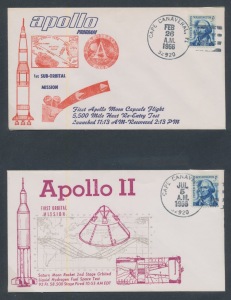Cover collecting is the generic term for collecting stamps on envelopes. It includes two broad categories: Postal historical covers, that is, stamps on envelopes collected to show the stamps as they were used for postal purposes, and Philatelic covers, that is, covers made for collectors, usually to commemorate some special event. Philatelic covers come in four broad types: First Day Covers, Naval or Ship covers, Airmail related covers, and Space covers. In most cases, philatelic covers grew out of a small group of classic preparers or “accidentals”—very early philatelic covers in each field that caught philatelists’ imaginations, rose in price and interest, and sparked more preparers and covers.
Phillip Ward was a young man when he practically invented the US First Day Cover market. Before 1909, First Day Covers existed, but they were accidentals—covers that just happened to have the stamp used on the first day because the postal patron went to the post office and was sold that stamp. Ward began an entirely new phenomenon—covers created for the hobby. He was soon followed by others, and before 1925, cachets were being applied to covers before they were cancelled as First Days. FDC’s caught the imagination of a new generation of collectors. These covers had pretentions of philatelic seriousness—after all, they were covers and had a feel like postal history which had already attracted the more erudite element of the hobby. Second, they were new, and the earliest FDC’s rose quickly in price. And third, FDC’s competed in a sparse philatelic world. The United States Post Office was issuing few stamps in the 1920s and 1930s. Because so few new issues were competing for their attention, collectors had plenty of time and money to devote to collecting variations of new stamps. By 1940, First day Covers were part of most collectors’ US collections.
In the 1920s, the greatest transportation technological invention since the wheel brought mail transport into the air. It’s hard to overemphasize how significant this was to communications and how it caught the interest of collectors. Influenced by early First Day Cover collecting, early Airmail enthusiasts had pilots carry letters, and soon both official and unofficial airmail covers were created, mostly with cachets. Airport opening and dedication covers soon followed. By 1930, there were thousands of different collectible Airmail cover varieties including airport dedications and first flights of new Airmail postal routes. Zeppelin covers were part of this trend.
Naval covers were more or less a copycat of the airmail phenomenon. Ship dedication covers abound as do port of call cachets and similar items. To philatelic professionals, who see the collections of people who collected in the 1930s, it seems that most philatelic time was spent creating these kind of covers and collecting them. The last of the major philatelic cover phenomena—space covers—began about 1960 and really had all the characteristics of a specialty in decline, even before it took off. The first orbit of the earth and the landing on the moon were highly significant events. But mail on these flights was nonexistent or higher controlled. So most space covers have an unofficial quality—commemorating the date that something occurred with a cover and an appropriate cachet or else commemorating events of very marginal significance such as satellite launches.
By 1970, philatelic cover collecting began its descent. A good rule of philatelic thumb—when major companies begin marketing philatelic products to the mainstream population, real stamp collectors run for the hills. The market for FDC’s and other philatelic covers died when the Reader’s Digest began a vast philatelic marketing campaign about 1980 and has never recovered. Today, servicing new First Day Covers is the easiest way to throw away your money. They cost $4 or more each to produce and are promptly worth about a dime. Ironically, going back and buying older philatelic covers is experiencing something of a comeback. Such covers sell for very little in auction lots and offer a wide and varied collecting experience.

